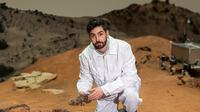Brief Enquiries Intro
Brief Enquiries – What drives researchers and what they are currently doing
Brief Enquiries Dr Ottaviano Ruesch
WHAT DOES MARS TEACH US ABOUT EARTH, MR RUESCH?
Dr Ottaviano RueschThe Swiss geologist, Dr Ottaviano Ruesch, has conducted research for the European Space Agency, ESA, at Noordwijk in the Netherlands and for the American Space Agency, NASA, in Greenbelt. He is now a Sofja Kovalevskaja Award Winner, heading his own research project in the Institute for Planetology at the University of Münster.
Brief Enquiries Dr Marta Brković Dodig
WHY SHOULD CHILDREN BUILD A SKYSCRAPER IN A MUSEUM, MS BRKOVIĆ DODIG?
into participatory activities. Marta Brković Dodig has run many such hands-on activities for children and young people. She is employing scientific methods to examine the young research field of Built Environment Education. “Blockholm” is a classic example of BEE, Built Environment Education. In the exhibition at the National Centre for Architecture and Design in Sweden, children, young people and adults have recreated the city of Stockholm using the computer game Minecraft. More than 100,000 designs have been produced. A jury selected ten models which were then presented on a scale of 1:5 in a follow-up exhibition. There are, or have been, similar events at museums in Chicago, Munich and Budapest. Together with her team, Marta Brković Dodig is collecting information on BEE programmes around the world, how they differ, and how their success can be evaluated. But why should children acquireexperience of town planning outside of school? “When it comes to urban planning and urban history, we want children to become informed citizens,” says Brković Dodig. Ultimately, it is all about democracy. “The city is the place where we live together. That’s why it’s important to be connected with it – with buildings and squares, with monuments, but also simply with places that are personally important to people.”
























 Brief Enquiries – What drives researchers and what they are currently doing
Brief Enquiries – What drives researchers and what they are currently doing
 WHAT DOES MARS TEACH US ABOUT EARTH, MR RUESCH?
WHAT DOES MARS TEACH US ABOUT EARTH, MR RUESCH?
 Dr Ottaviano Ruesch
Dr Ottaviano Ruesch
 WHY SHOULD CHILDREN BUILD A SKYSCRAPER IN A MUSEUM, MS BRKOVIĆ DODIG?
WHY SHOULD CHILDREN BUILD A SKYSCRAPER IN A MUSEUM, MS BRKOVIĆ DODIG?
 Dr Marta Brković Dodig
Dr Marta Brković Dodig
 WHAT DOES ANTARCTIC ICE TELL US ABOUT CLIMATE CHANGE, MR CASADO?
WHAT DOES ANTARCTIC ICE TELL US ABOUT CLIMATE CHANGE, MR CASADO?
 Dr Mathieu Casado
Dr Mathieu Casado
 HOW DO NEPTUNE, HERCULES AND CO. STILL INFLUENCE CHILDREN AROUND THE WORLD TODAY, MS MARCINIAK?
HOW DO NEPTUNE, HERCULES AND CO. STILL INFLUENCE CHILDREN AROUND THE WORLD TODAY, MS MARCINIAK?
 Dr Katarzyna Marciniak
Dr Katarzyna Marciniak
 HOW DOES A LANGUAGE APP HELP IN COURT, MR ABATE AND MS TACHBELIE?
HOW DOES A LANGUAGE APP HELP IN COURT, MR ABATE AND MS TACHBELIE?
 Dr Solomon Teferra Abate & Dr Martha Yifiru Tachbelie
Dr Solomon Teferra Abate & Dr Martha Yifiru Tachbelie
